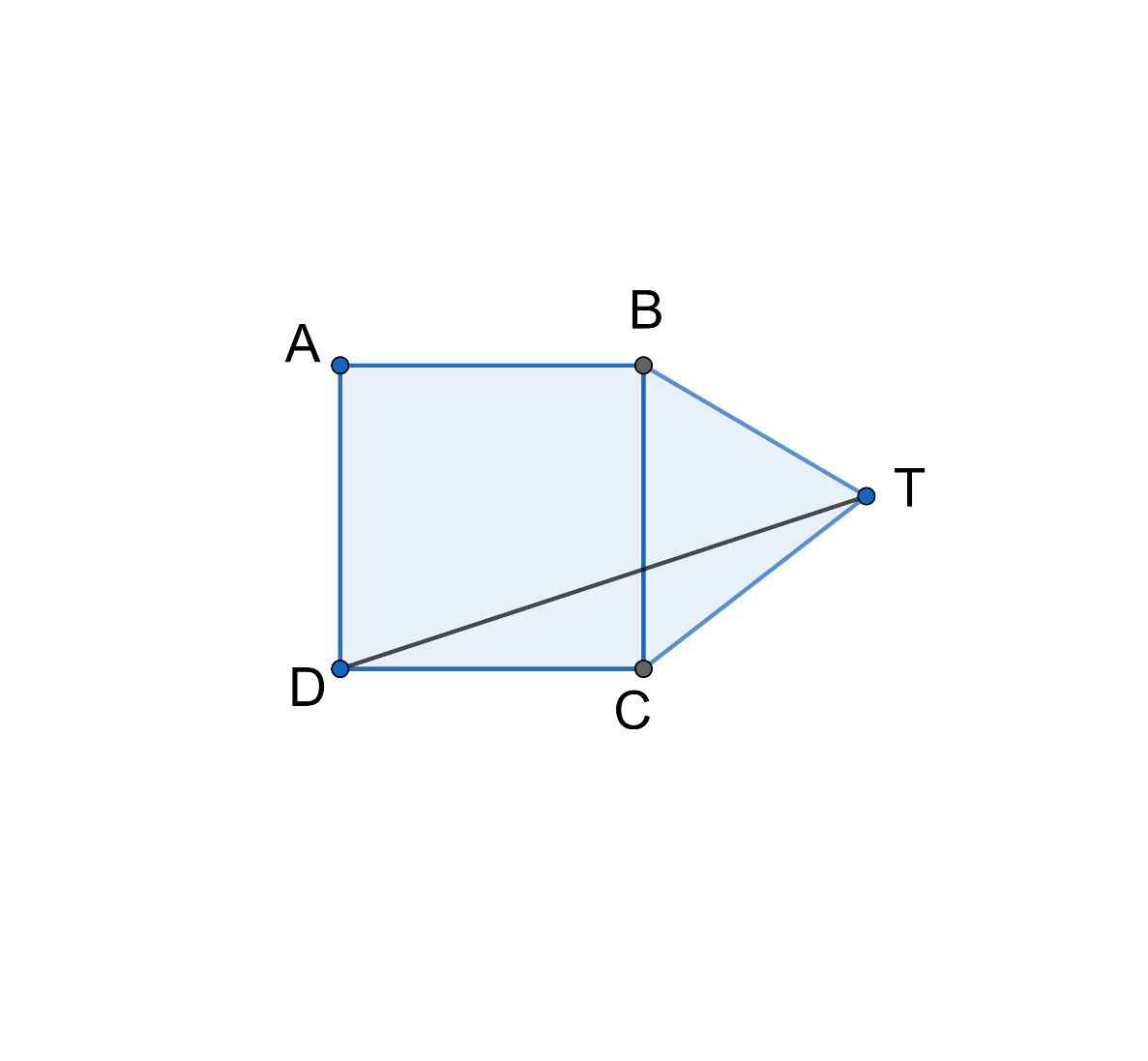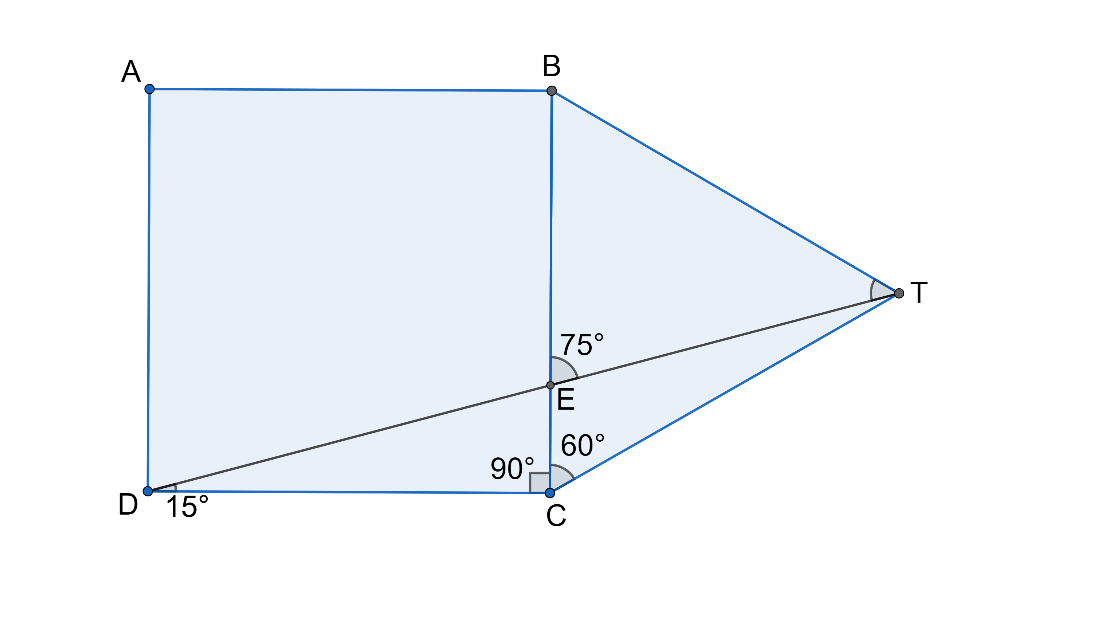
In the given diagram, ABCD is a square and $\Delta BCT$ is an equilateral triangle. $\angle BTD$equals

a) ${{30}^{\circ }}$
b) ${{15}^{\circ }}$
c) ${{45}^{\circ }}$
d) ${{35}^{\circ }}$

Answer
574.5k+ views
Hint: Since it is given that ABCD is a square and $\Delta BCT$ is an equilateral triangle. Use the properties of the square and equilateral triangle to find the relation between angles sides of the square and triangle. Then find $\angle BTD$.
Complete step-by-step answer:
As we know that ABCD is a square. Therefore, all the angles of the square are equal to ${{90}^{\circ }}$ .
So, we can say that $\angle BCD={{90}^{\circ }}$
Also, $\Delta BCT$ is an equilateral triangle. Therefore, all the angles of the equilateral triangle are equal to ${{60}^{\circ }}$.
So, we can say that $\angle BCT={{60}^{\circ }}$
Now, consider $\Delta TDC$ in the following figure.

As we know the sum of all angles of a triangle is ${{180}^{\circ }}$. So, we can say that:
$\angle TDC+\angle TCD+\angle DTC={{180}^{\circ }}......(1)$
As we know that BC is the common side of the square and the equilateral triangle. Therefore, we can say that:
CD = CT
In triangle $\Delta TDC$;
Since CD = CT, so $\Delta TDC$ is an isosceles triangle.
This implies that $\angle DTC=\angle TDC$
Let us assume that, $\angle TDC=\angle TCD=x$
So, we can write equation (1) as:
$\begin{align}
& \Rightarrow x+x+\angle TCD={{180}^{\circ }} \\
& \Rightarrow 2x+\angle TCD={{180}^{\circ }}......(1) \\
\end{align}$
Also,
$\begin{align}
& \angle TCD=\angle BCD+\angle BCT \\
& ={{90}^{\circ }}+{{60}^{\circ }} \\
& ={{150}^{\circ }}.....(2)
\end{align}$
Substitute equation (2) in equation (1), we get:
$\begin{align}
& \Rightarrow 2x+{{150}^{\circ }}={{180}^{\circ }} \\
& \Rightarrow 2x={{30}^{\circ }} \\
& \Rightarrow x={{15}^{\circ }} \\
\end{align}$
Hence, $\angle DTC={{15}^{\circ }}$
Now, in $\Delta BCT$, all the angles are equal to ${{60}^{\circ }}$
So, $\angle BTC={{60}^{\circ }}......(3)$
We can write equation (3) as:
$\begin{align}
& \Rightarrow \angle BTD+\angle DTC={{60}^{\circ }} \\
& \Rightarrow \angle BTD+{{15}^{\circ }}={{60}^{\circ }} \\
& \Rightarrow \angle BTD={{45}^{\circ }} \\
\end{align}$
So, the correct answer is “Option c”.
Note: There is another way to solve for $\angle BTD$
Since, we have found that $\angle TDC={{15}^{\circ }}$.
Let BC and TD intersect at point E as shown in the figure below. So, we have $BC\parallel AD$.

Therefore, $\angle ADE=\angle BET={{\left( 90-15 \right)}^{\circ }}$ [corresponding angles]
So, we have: $\angle BET={{75}^{\circ }}$
Now, in $\Delta BET$
$\begin{align}
& \Rightarrow \angle BTE+\angle BET+\angle TBE={{180}^{\circ }} \\
& \Rightarrow \angle BTE+{{75}^{\circ }}+{{60}^{\circ }}={{180}^{\circ }} \\
& \Rightarrow \angle BTE={{45}^{\circ }} \\
\end{align}$
Complete step-by-step answer:
As we know that ABCD is a square. Therefore, all the angles of the square are equal to ${{90}^{\circ }}$ .
So, we can say that $\angle BCD={{90}^{\circ }}$
Also, $\Delta BCT$ is an equilateral triangle. Therefore, all the angles of the equilateral triangle are equal to ${{60}^{\circ }}$.
So, we can say that $\angle BCT={{60}^{\circ }}$
Now, consider $\Delta TDC$ in the following figure.

As we know the sum of all angles of a triangle is ${{180}^{\circ }}$. So, we can say that:
$\angle TDC+\angle TCD+\angle DTC={{180}^{\circ }}......(1)$
As we know that BC is the common side of the square and the equilateral triangle. Therefore, we can say that:
CD = CT
In triangle $\Delta TDC$;
Since CD = CT, so $\Delta TDC$ is an isosceles triangle.
This implies that $\angle DTC=\angle TDC$
Let us assume that, $\angle TDC=\angle TCD=x$
So, we can write equation (1) as:
$\begin{align}
& \Rightarrow x+x+\angle TCD={{180}^{\circ }} \\
& \Rightarrow 2x+\angle TCD={{180}^{\circ }}......(1) \\
\end{align}$
Also,
$\begin{align}
& \angle TCD=\angle BCD+\angle BCT \\
& ={{90}^{\circ }}+{{60}^{\circ }} \\
& ={{150}^{\circ }}.....(2)
\end{align}$
Substitute equation (2) in equation (1), we get:
$\begin{align}
& \Rightarrow 2x+{{150}^{\circ }}={{180}^{\circ }} \\
& \Rightarrow 2x={{30}^{\circ }} \\
& \Rightarrow x={{15}^{\circ }} \\
\end{align}$
Hence, $\angle DTC={{15}^{\circ }}$
Now, in $\Delta BCT$, all the angles are equal to ${{60}^{\circ }}$
So, $\angle BTC={{60}^{\circ }}......(3)$
We can write equation (3) as:
$\begin{align}
& \Rightarrow \angle BTD+\angle DTC={{60}^{\circ }} \\
& \Rightarrow \angle BTD+{{15}^{\circ }}={{60}^{\circ }} \\
& \Rightarrow \angle BTD={{45}^{\circ }} \\
\end{align}$
So, the correct answer is “Option c”.
Note: There is another way to solve for $\angle BTD$
Since, we have found that $\angle TDC={{15}^{\circ }}$.
Let BC and TD intersect at point E as shown in the figure below. So, we have $BC\parallel AD$.

Therefore, $\angle ADE=\angle BET={{\left( 90-15 \right)}^{\circ }}$ [corresponding angles]
So, we have: $\angle BET={{75}^{\circ }}$
Now, in $\Delta BET$
$\begin{align}
& \Rightarrow \angle BTE+\angle BET+\angle TBE={{180}^{\circ }} \\
& \Rightarrow \angle BTE+{{75}^{\circ }}+{{60}^{\circ }}={{180}^{\circ }} \\
& \Rightarrow \angle BTE={{45}^{\circ }} \\
\end{align}$
Recently Updated Pages
Two men on either side of the cliff 90m height observe class 10 maths CBSE

What happens to glucose which enters nephron along class 10 biology CBSE

Cutting of the Chinese melon means A The business and class 10 social science CBSE

Write a dialogue with at least ten utterances between class 10 english CBSE

Show an aquatic food chain using the following organisms class 10 biology CBSE

A circle is inscribed in an equilateral triangle and class 10 maths CBSE

Trending doubts
Why is there a time difference of about 5 hours between class 10 social science CBSE

Write a letter to the principal requesting him to grant class 10 english CBSE

What is the median of the first 10 natural numbers class 10 maths CBSE

The Equation xxx + 2 is Satisfied when x is Equal to Class 10 Maths

Which of the following does not have a fundamental class 10 physics CBSE

State and prove converse of BPT Basic Proportionality class 10 maths CBSE




